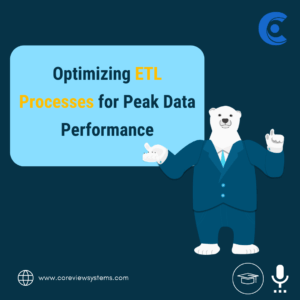Optimizing ETL Processes for Peak Data Performance

In today’s data-driven world, ensuring timely data insights and informed decision-making hinges on optimizing ETL (extract, transform, load) processes. As data volumes continue to soar, ETL processes can become bottlenecks, hindering data availability and performance. By implementing effective optimization strategies, you can ensure your ETL processes are running smoothly, delivering data at peak performance to fuel business growth.
Identifying and Addressing Bottlenecks
The first step towards optimization is to identify and address any bottlenecks in your ETL pipeline. These bottlenecks can occur at various stages, from data extraction to transformation to loading. Analyze the performance of each stage and pinpoint areas where data is slowing down. This could be due to inefficient data transfer methods, complex transformations, or slow target systems.
Optimizing Data Extraction
Data extraction is the initial stage of the ETL process, where data is retrieved from various sources. To optimize extraction, consider the following strategies:
-
Minimize data extraction: Extract only the data that is absolutely necessary for your analysis or applications. Avoid extracting unnecessary data that adds to the processing burden.
-
Schedule extraction during off-peak hours: Schedule data extraction tasks during times when source systems are less busy, reducing competition for network resources.
-
Utilize efficient data transfer methods: Employ efficient data transfer methods, such as compressed data formats or parallel processing, to speed up data extraction.
Streamlining Data Transformation
Data transformation involves cleaning, filtering, and converting data into a format suitable for analysis. Optimize this stage by:
-
Simplify transformations: Break down complex transformations into simpler steps to improve execution efficiency.
-
Utilize optimized SQL queries: Use optimized SQL queries to minimize the time required for data transformations.
-
Consider caching frequently used transformations: Cache frequently used transformations to reduce repetitive processing and improve performance.
Optimizing Data Loading
Data loading is the final stage of the ETL process, where transformed data is loaded into the target system. Optimize loading by:
-
Utilize bulk loading methods: Employ bulk loading techniques to load large amounts of data efficiently.
-
Partition target tables: Partition target tables are based on appropriate criteria to improve data distribution and loading performance.
-
Consider using parallel processing: Utilize parallel processing techniques to distribute data loading tasks across multiple nodes, reducing overall processing time.
Continuous Monitoring and Optimization
ETL optimization is an ongoing process, not a one-time event. Continuously monitor the performance of your ETL processes and identify areas for further improvement. Implement a feedback loop to incorporate optimization strategies and maintain peak performance as data volumes and processing requirements evolve.
By optimizing your ETL processes, you can ensure that your data is available when you need it, empowering you to make informed decisions and drive business growth. Embrace the power of data optimization and fuel your success in the data-driven world.
